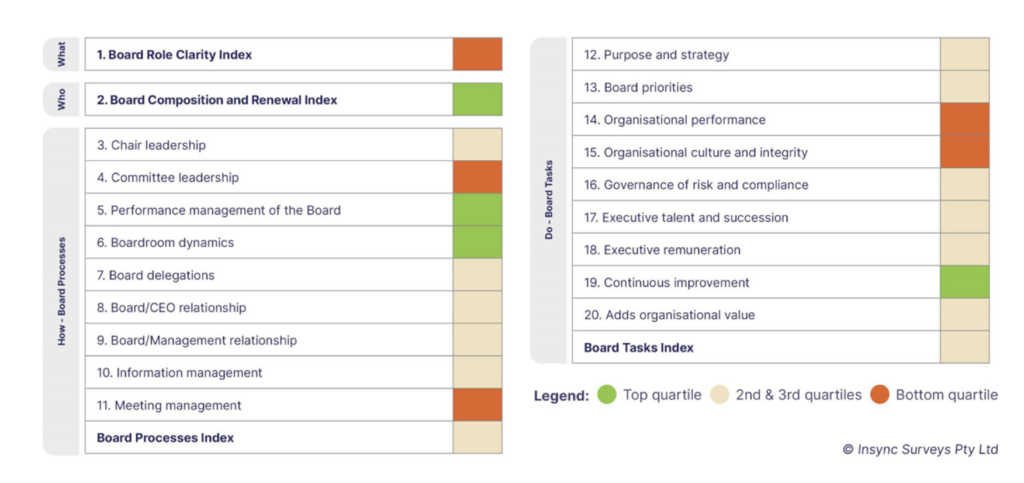Over 80% of drivers think they’re above average, and boards are no different. Many members view themselves as more effective than their peers.
Some boards conduct formal surveys among directors and sometimes even include senior executives. This seems like a smart move, right? You’re gathering data and involving more voices, and it’s all in the name of self-improvement. But when these surveys are handled internally, you might not get the whole, unvarnished truth. People tend to be less candid when they know their colleagues might scrutinise their responses.
Typically, the company secretary administers the board survey. Occasionally, an external party is brought in to handle this task, which can help get more honest feedback. But the real question we must ask is: Can we trust that these board surveys and the resulting reports reflect the board’s performance and effectiveness?
The self-perception trap
There’s an issue of self-perception. Just like the drivers who believe they are better than average, board members often think they’re doing better than they are. This cognitive bias can skew the results of any survey. If everyone on the board thinks they’re effective, the survey results might reflect this overconfidence rather than reality. This is especially true in internal surveys where the fear of rocking the boat might lead to overly positive responses.
The internal vs. external debate
When a company secretary administers the survey, there’s a risk that you wont receive the full unvarnished truth. Directors will often not want to be too critical if they know their feedback will be seen by someone they work with. On the other hand, bringing in an external party to conduct the survey can mitigate this risk. External facilitators can ensure anonymity and impartiality, providing more honest and useful feedback. But even then, the effectiveness of the survey hinges on how it’s designed and conducted.
Candidness and anonymity
For a board survey to be truly effective, candidness is key. Respondents must feel safe to share honest opinions without fear of retribution or awkwardness. Anonymity can help, but it’s not a cure-all. The way questions are phrased, the context in which the survey is conducted, and the follow-up actions all play significant roles in determining the robustness of the survey measurement and improvement process.
Understanding the survey validation process
Survey validation is key to ensuring that your board survey is telling you something useful. Larger professional service groups have validated their employee, customer, and other surveys for years, often partnering with universities or qualified empirical researchers to get the job done right.
So, what does the validation process involve? It’s not just a quick check to see if the questions make sense. Instead, it’s a deep dive involving psychometric and statistical analysis of a large dataset of survey responses. This includes both exploratory and confirmatory factor analysis. Essentially, these analyses check if the survey questions (or factors) reliably measure what they’re supposed to.
Think of it like this: if you’re trying to measure different aspects of board effectiveness, you want to ensure each question accurately reflects the specific factor it’s targeting. The exploratory analysis helps identify whether these factors hold up under scrutiny, while the confirmatory analysis verifies that the identified factors are consistent and reliable measures.
But it doesn’t stop there. The validation process also involves reviewing and combining the existing literature with significant practical experience. This step ensures that the survey aligns with contemporary practices and current research. It’s about making sure the survey isn’t just theoretically sound but also practically relevant.
The final step in the validation process is rigorous reporting, often culminating in publication in a peer-reviewed journal. This isn’t just a formality — it’s a way to ensure the process and results are scrutinised and validated by the broader academic and professional community. This level of rigour helps ensure that the survey is a reliable measure of board effectiveness.
Why go through all this trouble? Well, a validated survey means you can trust the results. It means that when the survey says your board is effective (or not), it’s based on solid, reliable data. Without validation, you’re flying blind, basing decisions on potentially flawed measures.
The validation gap: Why 99% of board surveys haven’t been validated
Every year, hundreds, if not thousands, of different board surveys are conducted worldwide. Yet, despite their widespread use, a staggering 99% of these surveys haven’t been validated. Most in-house surveys don’t even claim to be valid or reliable measures of a board’s effectiveness. They’re often designed for quick feedback rather than as a rigorous assessment.
Even when consultants step in to help most use a survey that has not yet been validated. They have rarely gathered enough data from a broad cross section of enough boards. Without sufficient data, these surveys can’t undergo the thorough the process needed to validate their reliability.
Our board survey stands out because it is one if the few, if not the only one, that has been through a validation process. We partnered with Deakin University to assist us with this important validation process. All the steps referred to under the validation section above were followed. This included psychometric and statistical analyses, literature reviews, and rigorous testing. The results of this process were so robust that they were reported in a peer-reviewed journal, adding an extra layer of credibility.
So, why does this matter for your board? Simply put, a survey can only be considered a reliable measure of board performance and effectiveness if it has been properly validated. Without this, the results are just educated guesses at best. We are unaware of any other board survey that has undergone such a stringent validation process. This means our survey and the resulting report is one of the few, if not the only reliable measures of a board’s performance and effectiveness.
Validation pinpoints key factors of board performance
As well as ensuring that a board survey is a reliable measure of board performance, the validation process identifies the most important factors that drive board performance.
Our journey began in 2005 with a collaboration involving a global governance expert, KPMG, and numerous experienced directors and governance practitioners. With their help, we designed a comprehensive board survey that initially included ten factors of a board’s effectiveness. This wasn’t just a shot in the dark; it was a carefully crafted tool aimed at covering all bases.
Once we had carried out around 200 board reviews we asked Deakin University to help us validate our board survey. That validation process resulted in us removing unsuitable or irrelevant survey items, ensuring only the most pertinent survey items remained. This thorough process also helped to pinpoint the 20 distinct components that are crucial to a board’s effectiveness.
This wasn’t a quick or easy task, but it was essential. It took us around 15 years to discover what now, in hindsight, seems bleeding obvious – there are 20 distinct factors that are crucial to measuring a board’s effectiveness and they are as follows.

Figure 1. 20 most important dimensions for a board’s effectiveness. The benchmarking is illustrative only .
Why it matters
The result is a survey that doesn’t just skim the surface but dives deep into what makes a board effective. All 20 factors identified are essential, addressing every critical element without leaving gaps. This comprehensive approach means that when you use our validated survey you get a measure of your board’s performance and effectiveness that can be relied upon.
In the end, rigorous validation separates a reliable survey from an unreliable one. If you’re planning to go through the process of using a board survey you might as well use one that has been validated as a reliable measure of board performance and effectiveness.
Why benchmarking adds significant value
Having a reliable measure of board effectiveness is crucial, but the extra value shines through when you benchmark your board survey responses against those of comparable boards who have used the same survey. This comparative approach amplifies the insights you gain, helping you understand where you truly stand.
Benchmarking your board against similar-sized organisations and within the same industry is essential. Imagine comparing the board of a financial services organisation to those of not-for-profits or government entities—it would be completely misleading. Each sector has its unique challenges and standards, so it’s vital to benchmark within the right context.
At Board Surveys, we offer comparisons against an appropriate comparable group selected from over 500 boards. By comparing your board’s performance with those of similar organisations, you get a clear picture of where you excel and where there’s room for improvement.
A validated board survey is a powerful tool on its own, but it becomes invaluable when paired with comprehensive and appropriate industry benchmarking. Our fit-for-purpose, affordable, and world-class survey options are designed to provide you with the most reliable and actionable insights.
If you’re going to do a job, do it right
There’s an old saying, If you’re going to do a job do it right. This quote is attributed to Jimmy John Liautaud.
We agree.
If you’re going to invest the time and money in doing a board survey, use one that you know will be a reliable measure of your board’s performance.


